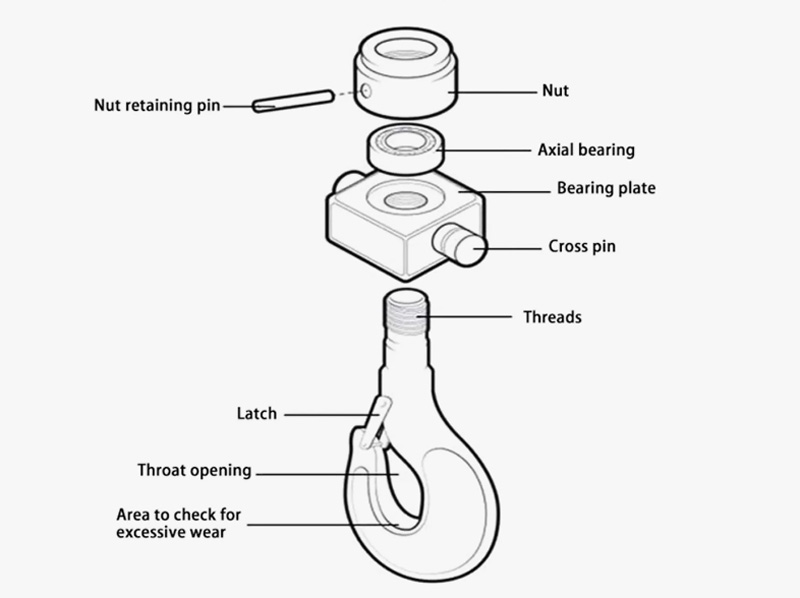우리가 크레인을 생각할 때, 우뚝 솟은 구조 나 강력한 윈치가 종종. 그러나 아마도 가장 중요하고 자주 간과되는 구성 요소는 겸손합니다. 크레인 후크. 리프팅 체인의 최종 링크입니다, 크레인이 부하를 충족시키는 지점. 해부학을 이해하는 것은 단순한 기술 전문 용어가 아닙니다; 안전하고 효율적인 리프팅 작업을위한 기본입니다. 크레인 훅의 주요 부분을 분해합시다:

후크 (또는 후크 바디):
그것이 무엇인지: 슬링을 단단히 고정하도록 설계된 상징적 인 곡선 부분, 족쇄, 또는 하중을 직접 요정하십시오.
기능: 부하에 대한 부착 및 베어링 표면의 주요 지점을 제공합니다.. 그 모양 (종종 깊은 "C"또는 "u") 장력 아래 부하가 미끄러지지 않도록 설계되었습니다..
주요 기능: 목구멍 개구부는 훅 포인트와 생크 사이의 거리입니다. (아래를 참조하십시오). 사용될 수있는 최대 슬링 또는 피팅의 최대 크기를 결정합니다..
요점 (또는 팁):
그것이 무엇인지: 후크 곡선의 끝.
기능: 1 차 하중 표면은 아닙니다, 손상된 슬링을 방지하기 위해 매끄럽고 닉이나 균열이 없어야합니다.. 모양은 후크의 슬링을 안내하는 데 도움이됩니다.
생크 (또는 구부러집니다):
그것이 무엇인지: 두꺼운, 똑바로(ish) 후크 곡선을 눈 또는 나사산 부분에 연결하는 섹션. 이것은 후크의 가장 강력한 부분입니다.
기능: 하중에 의해 생성 된 대부분의 인장 응력을 지니고 있습니다.. 단면은 정격 하중 용량을 처리하도록 설계되었습니다..
눈 (또는 크라운):
그것이 무엇인지: 강화 된, 후크 블록 또는 서스펜션 시스템에 연결되는 후크의 둥근 상단 섹션.
기능: 스위블 메커니즘을위한 부드러운 베어링 표면을 제공합니다 (존재한다면) 또는 서스펜션 핀/링크. 압축 및 전단력을 처리하도록 설계되었습니다.
스위블 (선택 사항이지만 일반적입니다):
그것이 무엇인지: 훅 아이와 서스펜션 링크/족쇄 사이에 통합 된 베어링 어셈블리.
기능: 후크를 허용합니다 (그리고 부하) 하중에서 자유롭게 회전합니다. 이것은로드 슬링과 와이어 로프의 비틀기를 방지합니다., 마모를 크게 줄이고 부하 포지셔닝을보다 쉽고 안전하게 만듭니다.. 베어링이있는 내부 및 외부 경주로 구성됩니다.
서스펜션 링크 / 족쇄 눈:
그것이 무엇인지: 후크 어셈블리가 크레인의 하단 하중 블록에 연결되는 훅 아이 또는 스위블 위의 지점 (핀 또는 족쇄를 통해).
기능: 리프팅 메커니즘에 부착 지점을 제공합니다. 종종 큰 구멍이나 핀 보어가 있습니다.
래치 (안전 걸쇠 또는 후크 클립):
그것이 무엇인지: 후크의 목구멍 개구부를 덮는 스프링로드 게이트 또는 클립.
기능: 안전에 결정적입니다! 슬링을 방지합니다, 쇠사슬, 또는 작동 중 훅 포인트에서 우연히 미끄러지거나 "점프"하는 다른 피팅, 특히 슬랙이 발생하는 경우. 안전 걸레를 물리 치지 마십시오!
유형: 일반적인 유형에는 스프링 래치가 포함됩니다 (자기 폐쇄) 게이트 키퍼 걸쇠 (수동 작동이지만 안전합니다).
목구멍:
그것이 무엇인지: 후크 바디의 곡선 내부의 열린 영역, 생크와 요점에 의해 경계.
기능: 슬링 또는로드 부착물이있는 곳입니다. 하중 베어링 포인트는 주로 하중이있는 정강이 내부의 특정 영역입니다..
안장 (또는 좌석):
그것이 무엇인지: 구체적, 정강이 내부의 약간 평평한 영역, 요점 반대.
기능: 하중의 무게를 지탱하도록 설계된 1 차 접촉점. 매끄럽고 손상이 없어야합니다. 슬링은 항상 안장에 올바르게 앉아 있어야합니다.

안전: 후크의 구조를 이해하면 임계 마모 지점을 식별하는 데 도움이됩니다 (안장이나 걸쇠처럼) 검사 중. 손상을 인식하면 치명적인 실패를 방지합니다.
점검: Riggers와 Inspectors는 균열을 정확히 찾아야합니다., 흉한 모습, 입다, 또는 래치 오작동 (ASME B30.10 및 OSHA 규정은 정기 검사를 요구합니다).
적절한 사용: 부하 베어링 포인트를 알고 있습니다 (안장) 슬링이 올바르게 장착되도록합니다. 목구멍 개구부를 이해하면 대형 부착물을 사용하는 것을 방지합니다.
의사소통: 올바른 용어를 사용하면 연산자 간의 명확한 의사 소통이 보장됩니다, 리거, 유지 보수 요원.
획득: 올바른 교체 부품을 주문하도록합니다 (예를 들어, 특정 래치 또는 스위블 어셈블리).
그만큼 크레인 후크 집중된 엔지니어링의 경이로움입니다. 각 부분은 엄청난 부하를 안전하게 전달하는 데 뚜렷하고 중요한 역할을합니다.. 강력한 생크 취급 장력에서 목구멍을 지키는 생명을 구하는 래치에 이르기까지, 이러한 구성 요소를 이해하는 것은 해제 작업에 관련된 사람에게는 협상 할 수 없습니다.. 이 중요한 하드웨어를 검사하고 유지하는 것의 중요성을 과소 평가하지 마십시오 - 리프트의 무결성, 그리고 잠재적으로 살고 있습니다, 그것에 의존합니다.
우리는 귀하의 의견을 소중히 여깁니다! 귀하의 특정 요구에 맞게 서비스를 조정할 수 있도록 아래 양식을 작성하십시오..

최신 의견